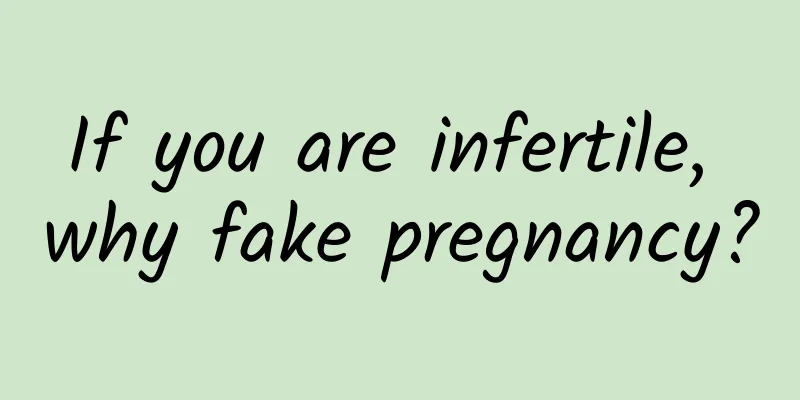If you are infertile, why fake pregnancy?

|
This is the 4404th article of Da Yi Xiao Hu Ms. Li, 40 years old, underwent laparoscopic ovarian cystectomy in March due to ovarian cysts. The postoperative pathological diagnosis was ovarian chocolate cysts, also known as endometriosis. When the doctor told her that it was probably endometriosis that caused her infertility in the past few years without taking contraceptives, her doubts for many years were finally solved. At the same time, she also had such a question in her heart: "Will the infertility factor be removed after this operation, so it will be easy to get pregnant naturally in the future?" With this question, she found her attending physician, and the answer she got was not affirmative, but uncertain. The doctor told her that she would need to use "pseudo-pregnancy therapy" for further treatment. This made Ms. Li even more confused. "If I am infertile, I still need to use pseudo-pregnancy to treat it. I won't get pregnant in the end, right?" After the second cesarean section, she didn't want to get pregnant again. So what is going on? This requires talking about what endometriosis is... What is endometriosis? Endometriosis refers to the appearance of endometrial tissue with growth function in other parts of the uterine cavity outside the endometrium and uterine body muscle layer. Ectopic endometrium has malignant behaviors such as proliferation, infiltration, metastasis and recurrence. It is an "active destructive element" that often scars wherever it goes. In addition, ectopic endometrium will bleed periodically with the changes in ovarian hormones. Repeated bleeding and slow absorption of the lesion can lead to proliferation and adhesion of surrounding tissues, and even the formation of nodules or masses. Endometriosis can be divided into the following 4 types according to the location of the uterus: 1. Ovarian type 80% of endometriosis is of ovarian type, which can be divided into minimal lesion type and typical lesion type according to the characteristics of the lesions. The former, as the name suggests, is a relatively small lesion, often a few millimeters of blue-purple cysts or spots located on the superficial surface of the ovary; the latter refers to the ectopic endometrium implanted and grown in the ovary, which bleeds continuously with the cyclical changes of the ovary, invades and destroys the normal ovarian tissue, and gradually forms a larger hematocystic cyst, whose contents are generally thick coffee-colored liquid, similar to chocolate liquid, so it is called ovarian chocolate cyst. 2. Peritoneal type Generally, it accounts for 10%-15% of endometriosis. It mainly refers to the superficial infiltration of ectopic endometrium on the surface of pelvic peritoneum or pelvic and abdominal organs. The depth of infiltration generally does not exceed 5mm. It is divided into pigmented type and non-pigmented type according to the pigmentation. The former generally manifests as blue-purple or brown nodules, while the latter manifests as red lesions and white lesions. This type of endometriosis is often difficult to detect and is mostly discovered during surgical exploration. 3. Deep infiltrating type This type of endometriosis has often reached a relatively serious stage. The depth of endometriosis often exceeds 5mm, and the invaded areas may involve the vaginal vault, uterine fundus ligament, rectouterine pouch, vaginal rectal septum, colorectal wall, bladder wall, and even ureter. It is very difficult to treat and often requires multidisciplinary treatment, and the prognosis is poor. 4. Other parts of the body Scar endometriosis, common ones include abdominal wall incision for cesarean section, perineal incision for normal delivery, etc.; distant endometriosis: endometriosis in distant parts such as lungs and brain. Why are patients with endometriosis prone to infertility? About 40% of patients with endometriosis will experience infertility. The real reason has not been clarified yet, but it is often considered to be related to the following factors: 1. Fallopian tube dysfunction Pelvic adhesions, such as adhesions of the uterus, ovaries, fallopian tubes and peritoneum, can easily cause twisting, stenosis or even blockage of the fallopian tubes, which not only affects the peristalsis of the fallopian tubes, but also hinders the passage of the fertilized egg. 2. Ovarian dysfunction Ectopic endometrium invades the ovaries, causing damage to normal ovarian tissue. In addition, pelvic and abdominal adhesions cause the ovaries to be wrapped, which can affect egg production and ovulation. 3. Environmental factors in the pelvic and abdominal cavity The pelvic and abdominal cavities of patients with endometriosis are often in a chronic inflammatory environment, and long-term exposure to inflammatory factors can reduce egg quality. (IV) Intrauterine environmental factors Endometriosis can affect the receptivity of the endometrium, thereby affecting embryo implantation and early development. (V) Others Some patients with endometriosis develop unruptured ovary luteinized syndrome, which can also cause ovulation disorders and lead to infertility. Why is pseudopregnancy therapy used after endometriosis surgery? The treatment of endometriosis mainly includes surgical treatment and drug treatment. Due to the stubbornness of the disease, there is no ideal radical cure except radical surgery (including bilateral adnexectomy, total hysterectomy + bilateral adnexes + endometriosis resection). For young patients or patients who need to retain fertility, conservative surgery (fertility-preserving surgery or ovarian-preserving surgery) is generally used. This type of surgery cannot completely achieve the purpose of cure and is prone to recurrence after surgery. Therefore, combined drug treatment is often required after surgery to prevent recurrence. Pseudopregnancy therapy is one of the commonly used methods in clinical practice. Its principle is to reduce the level of pituitary gonadotropin by using large doses of progesterone (such as gestrinone, etc.) or oral contraceptives and other hormones, and directly act on the endometrium, which then causes atrophy and amenorrhea of the ectopic and eutopic endometrium, and ultimately achieves the purpose of preventing or reducing the recurrence of postoperative endometriosis. Which patients are suitable for pseudopregnancy therapy? Pseudo-pregnancy therapy is not suitable for all patients after conservative surgical treatment. For patients who do not have fertility requirements, pseudo-pregnancy therapy can be considered after surgery, but contraindications of the drug (such as whether there is a risk of thrombosis, abnormal liver and kidney function, etc.) must be excluded before taking the drug; for patients who have fertility requirements, especially those over 35 years old and with low fertility function scores, pseudo-pregnancy therapy or other drug consolidation treatments should not be used after surgery. Ovulation induction or assisted reproductive technology should be used to increase the pregnancy rate and strive for early pregnancy. Once pregnant, a large amount of progesterone secreted in the body can inhibit the proliferation of ectopic endometrial cells and induce cell apoptosis. Long-term amenorrhea can significantly reduce or even eliminate endometriotic foci. A small number of patients can achieve the purpose of cure after the end of pregnancy. Therefore, in fact, both "pseudo-pregnancy" and "true pregnancy" can achieve the purpose of treating endometriosis. Can I get pregnant during pseudopregnancy therapy? Generally not. The drugs used in pseudopregnancy therapy are birth control pills or large doses of progestins, which have a contraceptive effect in addition to their therapeutic effect. Therefore, pregnancy will not occur if taken on time, unless a dose is missed, which may cause an unexpected pregnancy. However, once treatment is stopped, patients who do not want to have children should use regular contraceptive methods to prevent pregnancy. This "false pregnancy" is not that "false pregnancy" In addition to pseudopregnancy caused by pseudopregnancy therapy, there are indeed patients with pseudopregnancy in clinical practice. Such women often experience nausea, vomiting, cessation of menstruation and other pregnancy-like symptoms due to long-term infertility or eagerness to get pregnant, and excessive mental stress. Some even feel fetal movement or abdominal distension, but the human chorionic gonadotropin in the body does not increase, and ultrasound cannot detect any intrauterine or extrauterine pregnancy. It can be said that this pseudopregnancy is active, while pseudopregnancy therapy is passive. Conclusion: Pseudopregnancy therapy is an effective method currently used in clinical practice to treat endometriosis. However, before its application, the patient's general condition should be strictly evaluated to exclude contraindications. During long-term use, liver and kidney function should be monitored regularly, thrombosis risk should be assessed, and full management should be implemented to achieve the best therapeutic effect. Author: Department of Gynecology, Huadong Hospital, Fudan University Zhu LihongDeputy Chief Physician |
>>: Is orthodontic correction painful?
Recommend
What should women eat when they are upset?
Feeling irritable and upset are emotions that alm...
Can I get pregnant if I have sex two days after ovulation?
Generally, couples will go for a physical examina...
Bleeding at 9 weeks of pregnancy
If you experience bleeding during the ninth week ...
What to do if pregnant women have bloating
Pregnancy always causes various pregnancy reactio...
What to eat after miscarriage to enlarge breasts? Four breast enlargement medicinal diets
When a woman is pregnant, her body increases the ...
What causes anovulation?
Under normal circumstances, every time a woman ha...
What are the dangers of hypoglycemia in pregnant women?
Women will experience a lot of discomfort during ...
Causes of abdominal pain after cesarean section
When giving birth, there are two ways to choose f...
What should I do if I have stomach discomfort after childbirth?
In life, people often experience stomach discomfo...
What is the difference between pomegranate and guava? How to cut guava
Pomegranates are particularly nutritious and cont...
What causes bleeding from the nipple?
The lactation period is a very important period. ...
What to do if you have an ectopic pregnancy with an IUD?
An abnormal pregnancy process in which the fertil...
Results of the largest study of adolescent brain cognitive development to date released
American scientists wrote in the online version o...
What fruits and foods can't you eat during your period?
Women need to be careful at all times when they h...
How to calculate the time interval between contractions?
When a pregnant woman is about to give birth, she...









